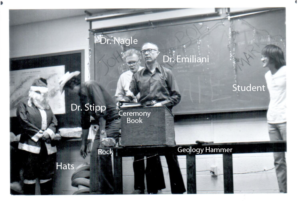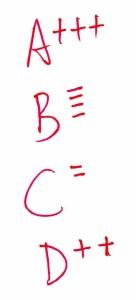
My father, Cesare Emiliani (Dott., Ph.D), was a long-time chair of the Geology department at the University of Miami in Coral Gables Florida. He was a creative, outgoing, and fun person who applied his gifts to how the department graduated its students. It was a separate ceremony that took place in a department classroom a week or so before the university held its official graduation ceremony.
This peculiar graduation ceremony was no doubt invented in the campus bar (or a bar nearby such as Bill & Ted’s Tavern or Duffy’s Tavern), and took place from the mid-1970s through the 1980s. Below is the department graduation ceremony as recounted by a former geology student, Douglas Introne, BS ’78, MS ’83) (edited slightly for clarity).
“The graduation ceremony was basically a roast of the student. They would show a slide show with pictures of the student that they had collected over the years from field trips, in the classroom, from The Rathskeller, or wherever, and they would make jest of him or her and basically just take the piss out of the student [from laughter]. Then each student would go up front to get his “Leghorn” — a Leghorn is an Italian Chicken — which was the straw cowboy hat with The U [logo] painted on the front and University of Miami graduation tassel pinned on top. The three professors, Emiliani, Stipp, and Nagle, would each punch, crush, step, stomp, etc., on it and mangle it, and then put it on your head. Then your old man [Prof. Emiliani] would move the tassel from one side of the hat to the other, and then you’d go back and shake each one of the three professors’ hands. Then the next kid came up. And that’s how you had graduated from the department.”
Another recollection by James Folcik:
“Still have my Leghorn (BS ’82). The prof gauntlet for the hat included squishing in an arm pit. They didn’t want us to look like rookies. Our roastings included baby and awkward teen photos. Starting with the youngest baby photo the audience was asked to guess who the next graduate was. In my year, all of us geo grads snuck our white hats (with tassels) under our gowns at the official university graduation ceremony and replaced our mortarboards with them after everyone was seated. Really stood out in a sea of black. Can’t tell you how many ‘Who are you guys?’ we got.”
To roast each student, you had to get to know them pretty well. This familiarity came about not just through classroom interaction, but in geology field trips, while dining together, and (especially) while drinking beers together and discussing geology.
There was a palpable respect for students, a collegial atmosphere between geology department faculty, staff, and students, a tremendous desire among the faculty for students to succeed in school and in their job after graduation. The department graduation ceremony evidences these special attributes of undergraduate studies in geology at the University of Miami during the time my father was department chair.
A funny story recounted by James Folcik:
“Best story – I was on a flight and ended up sitting next to a Geo Dept alum. He told me once that your father gave a student a grade of -273 (absolute zero in deg C) on a paper or test (can’t remember) because the student ‘knew absolutely nothing about the subject’.”
 Cesare was the rare full professor who insisted on teaching courses to undergraduates – one for non-science majors with 100 or so students and two for geology majors with 30 or so students each, plus his graduate courses (a total of three per semester). He gave students lots of breaks when the situation legitimately warranted it. One example is the way he graded undergraduate students on exams (he graded all exams himself; no teaching assistants). He was not a straight-up A-B-C-D-F grader, which was the official university grading system (no plus or minus allowed for final grades). Instead, his grading was more nuanced carried implied performance messages. The image at right shows an example of how he graded exams.
Cesare was the rare full professor who insisted on teaching courses to undergraduates – one for non-science majors with 100 or so students and two for geology majors with 30 or so students each, plus his graduate courses (a total of three per semester). He gave students lots of breaks when the situation legitimately warranted it. One example is the way he graded undergraduate students on exams (he graded all exams himself; no teaching assistants). He was not a straight-up A-B-C-D-F grader, which was the official university grading system (no plus or minus allowed for final grades). Instead, his grading was more nuanced carried implied performance messages. The image at right shows an example of how he graded exams.
A+++ meant you were doing really well; keep up the good work. B- – – – meant you are seriously close to getting a C next time if you don’t study harder. It also means “I’ll do a lot to help you avoid getting a C.” C- – – meant you are falling below C average and need to work harder. D++ means you might be able to pull your grade up to a C next time. It also means “I’m trying to help you not fail.” The grading system he used quietly transmitted positive emotional and work-related messages to students.
